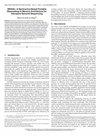模拟我们的安全软件之路:集成微体系结构模拟和泄漏估计建模的故事
IF 1.4
3区 计算机科学
Q4 COMPUTER SCIENCE, HARDWARE & ARCHITECTURE
引用次数: 0
摘要
保护软件免受侧通道漏洞攻击的一个重要步骤是使用标准泄漏测试在目标硬件上对其进行严格评估。最近,泄漏估计工具受到了很多关注,以改进这一耗时的过程。尽管已有工具取得了进步,但它们往往忽略了微体系结构及其泄漏模型中潜在事件的影响,这导致了不准确。本文通过将物理侧信道泄漏估计工具集成到微体系结构模拟器中,迈出了解决这些问题的第一步。为了实现这一点,我们首先系统地探索了各种体系结构和微体系结构活动及其潜在相互作用对产生的物理侧通道信号的影响,并将其集成到微体系结构模型中。其次,为了创建一个全面的泄漏估计报告,我们利用污染跟踪和符号执行来准确分析不同的路径和输入。这项工作的最终结果是一个工具,它采用二进制文件并生成一份泄漏报告,该报告涵盖了数据相关和路径相关信息泄漏场景中与体系结构和微体系结构相关的泄漏。本文章由计算机程序翻译,如有差异,请以英文原文为准。
Simulating Our Way to Safer Software: A Tale of Integrating Microarchitecture Simulation and Leakage Estimation Modeling
An important step to protect software against side-channel vulnerability is to rigorously evaluate it on the target hardware using standard leakage tests. Recently, leakage estimation tools have received a lot of attention to improve this time-consuming process. Despite their advancements, existing tools often neglect the impact of microarchitecture and its underlying events in their leakage model which leads to inaccuracies. This paper takes the first step in addressing these issues by integrating a physical side-channel leakage estimation tool into a microarchitectural simulator. To achieve this, we first systematically explore the impact of various architecture and microarchitecture activities and their underlying interactions on the produced physical side-channel signals and integrate that into the microarchitecture model. Second, to create a comprehensive leakage estimation report, we leverage taint tracking and symbolic execution to accurately analyze different paths and inputs. The final outcome of this work is a tool that takes a binary and generates a leakage report that covers architecture and microarchitecture-related leakages for both data-dependent and path-dependent information leakage scenarios.
求助全文
通过发布文献求助,成功后即可免费获取论文全文。
去求助
来源期刊

IEEE Computer Architecture Letters
COMPUTER SCIENCE, HARDWARE & ARCHITECTURE-
CiteScore
4.60
自引率
4.30%
发文量
29
期刊介绍:
IEEE Computer Architecture Letters is a rigorously peer-reviewed forum for publishing early, high-impact results in the areas of uni- and multiprocessor computer systems, computer architecture, microarchitecture, workload characterization, performance evaluation and simulation techniques, and power-aware computing. Submissions are welcomed on any topic in computer architecture, especially but not limited to: microprocessor and multiprocessor systems, microarchitecture and ILP processors, workload characterization, performance evaluation and simulation techniques, compiler-hardware and operating system-hardware interactions, interconnect architectures, memory and cache systems, power and thermal issues at the architecture level, I/O architectures and techniques, independent validation of previously published results, analysis of unsuccessful techniques, domain-specific processor architectures (e.g., embedded, graphics, network, etc.), real-time and high-availability architectures, reconfigurable systems.
 求助内容:
求助内容: 应助结果提醒方式:
应助结果提醒方式:


